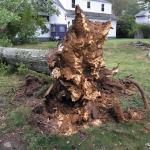UMass Extension's Landscape Message is an educational newsletter intended to inform and guide Massachusetts Green Industry professionals in the management of our collective landscape. Detailed reports from scouts and Extension specialists on growing conditions, pest activity, and cultural practices for the management of woody ornamentals, trees, and turf are regular features. The following issue has been updated to provide timely management information and the latest regional news and environmental data.
To read individual sections of the message, click on the section headings below to expand the content:
Scouting Information by Region
Environmental Data
The following data was collected on or about October 4. Total accumulated growing degree days (GDD) represent the heating units above a 50° F baseline temperature collected via our instruments for the 2017 calendar year. This information is intended for use as a guide for monitoring the developmental stages of pests in your location and planning management strategies accordingly.
|
MA Region/Location |
GDD |
Soil Temp |
Precipitation |
Time/Date of Readings |
||
|
2-Week Gain |
2017 Total |
Sun |
Shade |
|||
|
Cape Cod |
172.5 |
2470.5 |
62 |
57 |
1.74 |
12:00 PM 10/4 |
|
Southeast |
n/a |
2145 |
66 |
60 |
3.13 |
5:45 PM 10/4 |
|
North Shore |
190 |
2543 |
57 |
53 |
0.58 |
9:30 AM 10/4 |
|
East |
204 |
2771.5 |
64 |
62 |
0.77 |
3:30 PM 10/4 |
|
Metro West |
172.5 |
2455.5 |
58 |
55 |
0.12 |
5:35 AM 10/4 |
|
Central |
196 |
2493 |
64 |
61 |
0.00 |
2:00 PM 10/5 |
|
Pioneer Valley |
238 |
2623 |
58 |
57 |
0.14 |
11:00 AM 10/4 |
|
Berkshires |
212 |
2295 |
54 |
53 |
0.10 |
9:30 AM 10/4 |
|
AVERAGE |
198 |
2475 |
60 |
57 |
0.82 |
- |
|
n/a = information not available |
||||||
Drought Status: Approximately 90% of Massachusetts is under official drought status at this time. The Cape, the islands, and a small portion of southwestern Berkshire County are about the only areas currently unaffected. For more information see http://droughtmonitor.unl.edu/CurrentMap/StateDroughtMonitor.aspx?MA
Regional Notes
Cape Cod Region (Barnstable)
General Conditions: The average temperature from Sept. 20 - Oct. 4 was approximately 62° F with a high of 81° F on September 27 and a low of 43° F on October 3. The period began with the remnants of Jose which brought seven days starting in the previous period with zero sunshine, 100% RH, on and off rain, fog and wind. Conditions were perfect for growing mold. The end of the period included seasonable weather with lows in the 40s and high in the 70s, very comfortable conditions. During the period 1.74 inches of precipitation fell spread over several days from September 20-26.
Pests/Problems: Insect problems seen during the period include viburnum leaf beetle egg laying damage, chilli thrips on hydrangea, and turpentine beetle damage to pitch pine. Red oak borer damage can be seen at the base of many black, red and occasionally white oaks. The attacks are likely encouraged by the overall poor health of oak trees on the Cape. In some areas tree mortality is widespread as a result of many past stresses including winter moth, gypsy moth, cynipid gall wasp, and last year’s drought. The long period of wet conditions as a result of Jose have really encouraged the buildup of foliar diseases, in many situations leading to premature defoliation. Weeds in bloom include Pennsylvania smartweed (Polygonum lanceolata), Japanese knotweed (Polygonum cuspidatum), ragweed (Ambrosia artemisiifolia), crabgrass (Digitaria spp.), and mugwort (Artemisia vulgaris). Germination of winter annuals including hairy bittercress (Cardamine hirsuta) and chickweed (Stellaria media) has begun.
Southeast Region (Hanson)
General Conditions: On September 21-23, the remnants of Hurricane Jose brought constant high/gusty winds, drizzle, lower temperatures and 2.93 inches of much-needed rain. Temperatures the following week were in the low to mid 80’s with high humidity. Temperatures and humidity have since dropped, with lovely fall weather being the norm. Prior to the rain mid-September, Hanson had received only 5.10 inches of rain over an approximate 12-week period and a total of 8.25 inches for the past 14 weeks. Soils have been very dry and along with the high temperatures, un-irrigated plants have been stressed. According to the U. S. Drought Monitor, most of southeastern MA is rated as “abnormally dry”. (http://droughtmonitor.unl.edu/CurrentMap/StateDroughtMonitor.aspx?MA).
Continue to remind clients to water high value trees and shrubs and especially those recently planted or defoliated by caterpillars this past spring. Many of the stressed trees have not fully recovered from last year’s extreme drought and more rain is needed, especially as plants go into dormancy.
The following plants continue to bloom: fall asters, goldenrod, roses, Butterfly bush, Hydrangea paniculata, Persicaria sp., Eupatorium rugosum ‘Chocolate’, Japanese anemone, Actaea (Cimicifuga) simplex, Sedum sp., Corydalis lutea, Montauk daisyand Lamium. The colorful fruits of many landscape plants are also providing interest: viburnums, hollies, crabapples, Kousa dogwood and flowering dogwood.
Fall color has not begun in the Hanson area and many drought-stressed plants are exhibiting marginal leaf burn, brown foliage and/or leaf drop; similar to this time last year. It will be interesting to see if we have a colorful fall or not. It does not look promising but time will tell.
Painted lady butterflies and cabbage butterflies continue to be seen. Hummingbirds left the site in Hanson around Sept.13, although a lone, probably migratory hummingbird did show up at the feeders on September 26, for 2 days, before moving on. Hanson has 3,964 GDD (Growing Degree Days) Base 40.
Pests/Problems: Drought stress is the concern right now, as insect activity has slowed down.
However, be on the lookout for wasps and hornets as their nests are large and may be in the ground, hidden in tree hollows, branches, behind siding, etc. at this time of year and if disturbed, or threatened, they may attack and could possibly cause a medical problem to victims.
https://www.youtube.com/watch?v=kFaEG86BV_o&feature=youtu.be
Also, continue to monitor pines for sawflies, and rhododendrons, azaleas, and Pieris for lacebugs and manage if found. Slugs, aphids, snails, leafhoppers and mites remain active.
Mosquito populations have decreased although West Nile Virus has been found in some areas of the state, so continue to take precautions and use repellents. The same advice is given with regard to deer ticks which are active so continue toconduct tick checks frequently, and use insect repellent, especially during fall cleanups, when raking leaves, etc.
This is the time of year when some insects seek shelter to overwinter in buildings. Insects like: western conifer seed bugs, boxelder bugs, and lady beetles. These insects are usually considered nuisance pests, and usually do not warrant the use of insecticides indoors. Another newcomer to this list of insects that seek to overwinter in homes is the brown marmorated stink bug. This insect has been found in Massachusetts but not in every community.
- https://www.epa.gov/safepestcontrol/brown-marmorated-stink-bug#bug
- https://massnrc.org/pests/pestFAQsheets/brownmarmoratedstinkbug.html
- https://www.massnrc.org/pests/linkeddocuments/BMSBFactSheet.pdf
Several people have commented on “the disease affecting” Norway maples. The disease is Tar spot and maybe it is more prevalent in some areas this year but it is a disease that is common on Norway and silver maples almost every year and treatment is usually not recommended.
Deer continue to browse.
North Shore (Beverly)
General Conditions: Summer like conditions continued most of this reporting period. It was unseasonably hot and humid for this time of the year. Temperatures were mostly in the low to mid 80s during the day and in the low 60s during the night. The last few days of this reporting period were more seasonable with day temperatures in mid 60s and night temperatures in the low and mid-50s. There was dense fog during the mornings on some of the days, and we accumulated 190 growing degree days for a total of 2543 degree days for the year. Rainfall occurred in the area on only three days during the two-week period. Approximately 0.58 inches of rainfall were received at Long Hill. Plants seen in bloom include: White fountain Bush clover (Lespedeza thunbergii), False aster (Boltonia asteroides), Chocolate joe pye weed (Eupatorium rugosum), Plumbago (Ceratostigma plumbaginoides), Turtle head (Chelone sp.), Hardy Begonia (Begonia grandis), Hardy cyclamen (Cyclamen coum), Autumn joy sedum (Sedum spp.), Rudbeckia (Rudbeckia hirta), Coneflower (Echinacea purpurea), Japanese anemone and Autumn Crocus (Colchicum autumnale). Some annuals are also contributing color in the landscape.
Pests/Problems: Marginal leaf burn was observed on Japanese stewartia and on peony probably caused by anthracnose. Powdery mildew continue to be observed on lilac, beebalm (Monarda) and phlox. Tar spot and anthracnose are prevalent on maple trees. Some shrubs and trees are showing signs of drought stress such as early fall color, leaf scorch and early leaf drop. Mosquito activity has declined but ticks continue to be active. Remember to protect yourself with repellent when working outdoors and in the woods.
East Region (Boston)
General Conditions: The unseasonably warm weather in New England continues. Following windy conditions from Tropical Storm José, which caused only minor damage to the collections, we experienced normal conditions until a warm front moved in on the 24th. Temperatures soared reaching the mid- to high-80’s from the 24th to the 27th, hitting temperatures 15° F to 20° F above average for this time of year. Seasonal conditions returned as a cold front moved in and dropped half an inch of precipitation on the 30th. Over the last two weeks, highs have ranged from 56° F to 88° F, averaging 74° F, while lows have ranged from 41° F to 66° F, averaging 55° F. For the month of September, the average temperature was 66.9° F, 2 degrees warmer than the historical average of 64.9° F. For the month of September, we’ve experienced 11 days with temperatures in the 80’s and have received a total of 4.03 inches of rain; despite all this rain, the region is experiencing abnormally dry conditions. Plants in bloom include: Abelia chinensis (Chinese abelia), Aralia septemlobus (castor aralia), many Aster spp., (asters), Heptacodium miconioides (seven-son flower), Nipponanthemum nipponicum (Montauk daisy), many Sedum spp. (stonecrop, sedum), many Solidago spp. (goldenrod), and Symphyotrichum novae-angliae (New England aster). Fruit is visible throughout the landscape including: Cornus florida (flowering dogwood), Ilex verticillata (winterberry), Malus spp. (apple, crabapple), Viburnum dentatum (southern arrowwood), and V. dilatatum (linden arrowwood). Nut fruit continues to fall from Carya spp. (hickory), Castanea mollissima (Chinese chestnut), Juglans nigra (black walnut), and Quercus spp. (oak).
Pests/Problems: Soils in the area are somewhat dry, but not excessively dry. Supplemental watering is on hold, as plants are not showing signs of stress. Many Hymenoptera (sawflies, wasps, bees, and ants) are busy at work preparing for the winter; bees and wasps continue to be aggressive at this time of year. Gypsy moth egg masses are evident on trees.
Metro West (Acton)
General Conditions: The dry weather pattern continued throughout this reporting period and the warm late summer temperatures persisted as well. The forecasts for rain that were to be accompanied with the recent series of tropical storms and hurricanes never resulted in any of the much-needed rain for this area. The average monthly precipitation for September is 3.77” and the total measured for the month was 2.27”. Plants seen in bloom this past couple of weeks include: Aster spp. (New England Aster, New York Aster, Smoother Aster, White Wood Aster), A. tataricus (Tatarian Aster), Buddleia spp. (Butterfly Bush), Clematis paniculata (Sweet Autumn Clematis), Colchicum spp. (Fall Crocus), Franklinia alatahama (Franklin Tree), Hibiscus syriacus (Rose-of-Sharon), Kirengeshoma palmata (Yellow Wax Bells), Nipponanthemum nipponicum (Montauk Daisy), Potentilla fruiticosa (Potentilla), and Rosa 'Knockout' (The Knockout family of Roses). Fruits, pomes, seeds are providing some additional interest in the landscape. Seen are the red fruits on Cornus florida (Flowering Dogwood), C. kousa (Kousa Dogwood) and Ilex verticilata (Winterberry),a variety of colors and sizes of fruit on the Callicarpa dichotoma (Beautyberry), Cornus racemosa (Gray Dogwood), Crataegus spp. (Hawthorn), Malus spp. (Apple and Crabapple), Rosa spp. (Rose), Sorbus spp. (Mountain Ash), and Viburnums spp., seed heads on ornamental grasses, seedpods on Catalpa sp., and nuts on Carya spp. (Hickory), Heptacodium miconioides (Seven-Son Flower), Juglans spp. (Walnut) and Quercus spp. (Oak).
Pests/Problems: As a result of the dry and warm weather, the United States Drought Monitor has declared this reporting area, as well as east, north and south of here to be experiencing an abnormal drought. Signs of plant stress are apparent in the landscape including premature leaf wilt, drop, discoloration, scorch, and early fall color.
Central Region (Boylston)
General Conditions: Summer, it seems, is the new fall! The weather for most of the reporting period was quite warm and humid, though September 30th and October 1st were cooler only in the 50’s and lower 60’s. The evening temperatures plunged into the upper 30’s and low 40’s throughout the region on those evenings. A trace amount of rain fell the evening of September 29th and damp conditions continued into the 30th. Otherwise no measurable rain has fallen.Conditions have been remarkably warm and quite dry, leaving beds and borders and turf in need of supplemental irrigation. Japanese Anemones (A. tomentosa ‘Robustissima’ and other Anemone cultivars), Chrysanthemum weyrichii ‘White Bomb’, the last of the Heptacodium miconioides flowers, Clematis terniflora, and many annuals and tender perennials are still flourishing in gardens, Fall foliage color is ramping up, still most evident on red maples, Parthenocissus, Prunus maackii, and plants under stress. Fruit color on Kousa dogwood (Cornus kousa), winterberry (Ilex verticillata cultivars), Meserve holly (Ilex x meserveae cultivars), fringetree (Chionanthus retusus) and crabapples (Malus sp.) is developing nicely and each has abundant fruit set this year.
Pests/Problems: Dry conditions remain the most pressing problem in the area, though we are also seeing squash bugs and nymphs, dogwood sawfly caterpillars, three-lined potato beetles, and leaf miner on Swiss chard. Ticks are becoming active again. Fungal diseases like powdery mildew on lilac, peonies and phlox; tar spot on winterberry; and anthracnose on maples are evident.
Pioneer Valley Region (Amherst)
General Conditions: What a strange September it was in the Pioneer Valley. The Northeast Regional Climate Center has a nice summary of the contrasting weather we experienced last month (http://www.nrcc.cornell.edu/services/blog/2017/10/02/index.html). To summarize, the first half of September was cooler than average and we accumulated significant rainfall over the Labor Day weekend. Little did we know that would be the last meaningful rain event for the month. After temperatures cooled in late August and we got that soaking rain over Labor Day weekend, September was shaping up to be a great month for transplanting trees and shrubs and establishing/rehabilitating turfgrasses. Then we settled into an uncharacteristically warm stretch for the second half of the month, complete with a heat wave! Ambient air temperatures peaked in the low 90s in the valley from 9/24 through 9/26, bookended by upper 80s on 9/23 and 9/27. Dew points also climbed to uncomfortable levels, sending the heat index into the middle and upper 90s at times. The end result was a miserable stretch of heat this late in the season. Established lawns without irrigation range from fairly green to parched and browning. The heat finally broke on 9/28 and we experienced our first rainfall in weeks on Saturday, 9/30. Unfortunately, accumulations were pathetic for much of the valley, ranging from 0.1″ in Easthampton and Springfield to 0.2″ in Greenfield. Eastern portions of the valley did a bit better, with 0.5″ recorded in New Salem. When you’re jealous of a half inch of rain, you know it’s been dry. According to the U.S. Drought Monitor, all of Franklin, Hampshire and Hampden Counties are now classified as having abnormally dry conditions (the lowest drought intensity classification). Surface and subsurface soils are dry, so continue to water deciduous and evergreen trees and shrubs. Overhead lawn sprinklers are not sufficient for watering trees and shrubs in most settings. When plants suffer drought stress as they enter dormancy, cold hardiness can be adversely affected, leading to increased rates of winter injury. It appears to be heavy seed year for certain landscape and forest sugar maples. Hordes of samaras have been raining down from mature trees and the lack of any storms (and accompanying winds) may be one reason why so many are falling at once (aside from maturity and senescence). With more seasonable temperatures lately and their respective cool nights, soil temperatures are dropping fast. The extended forecast calls for wet weather and we should hope for significant accumulations to ease the recent dry spell. Overall, this was a good growing season due to the abundant early season rainfall.
Pests/Problems: Continue to monitor and treat for the spruce spider mite on landscape conifers. Given the dry weather, the thin strands of webbing may be present on the interior of infested branches and shoots. Use a registered miticide, insecticidal soap or horticultural oil for control, keeping in mind that soaps and oils can burn tender new growth (arborvitae can flush new growth during the autumn season). Syringing (blasting mites out of the canopy with a strong jet of water) can also be effective at suppressing populations when performed regularly but will not be as effective as a miticide. Anthracnose fungi have been active on a range of deciduous hardwoods, as they often re-emerge from summer dormancy in autumn as leaves are senescing. Sugar maples are browning and shedding foliage at this time, likely owing to the dry conditions in recent weeks and foliar pathogens. Given the abundant early season precipitation, most of these trees will likely be robust and healthy next spring. Needle cast pathogens on conifers are also sporulating at this time. For spruce needle cast pathogens, fall applications of fungicides are likely necessary to successfully combat the problem. Pathogens like Rhizosphaera are capable of sporulating all season long, but are most active during the spring and fall months. Given the extremely high levels of inoculum and the condition of many landscape spruces (e.g. old and declining blue spruce), the question of whether it’s even worth the time and money managing for needle cast diseases is warranted. The drying soil over the past several weeks seems to have suppressed mushroom production for certain wood-rotting fungi. Clusters of Armillaria mushrooms were observed on dead forest oaks but few of the cream-colored clusters have been seen on landscape trees, owing to their exposed setting in most cases. Many landscape crabapple and apple are devoid of leaves at this time. Making an extra effort to clean up discarded leaves this fall may help to reduce local inoculum, as many of these dead leaves are harboring the apple scab and marssonina leaf blight pathogens. Continue to prune and discard blighted stems and branches from the canopy of newly planted and established trees to remove cankering pathogens like Phomopsis and Botryosphaeria that may be present.
Berkshire Region (Great Barrington)
General Conditions: Weather oddities continued over the two week reporting period. Some of the hottest weather of the year occurred with the arrival of fall. Temperatures from September 23-27 were well into the 80s with record high temperatures on the 24th, 25th, 26th, and 27th. After that hot stretch, temperatures dropped to near or just below normal. Widely scattered frost occurred on the morning of October 2nd. Frost was most prevalent in valleys. The frost did provide an opportunity to evaluate frost tolerant species of annuals. Bachelor’s button (Centaurea cyanus), calendula (Calendula officinalis), annual dianthus (Dianthus chinensis), osteospermum (Osteospermum spp.), snapdragon (Antirrhinum majus), and sweet alyssum (Lobularia maritima) were observed to be free of frost damage in gardens where zinnias (Zinnia spp.), morning glories (Ipomoea spp.), and begonias (Begonia spp.) were affected. Another prominent factor affecting health and vigor of landscape plants during this period was the lack of rainfall, only 0.10 inches. At the beginning of September, rainfall for the year was about 2 inches above normal. As of October 4th, annual rainfall is about ¾ inch below normal. Premature fall color and substantial leaf drop are reflective of the dry period.
Pests/Problems: Few plant pests are active at this time though aphids can still be found on many host plants and grubs of Japanese beetle and other root feeders will be found when digging soil. Reports of deer tick attachments and bites have increased in recent weeks. Much of this is no doubt related to fall cleanup activities. Fallen leaves are a favorite locale for deer ticks. Gnats are being a nuisance as clouds of them quickly surround anyone traversing outdoors. As is the case every fall with dropping temperatures, certain insects seek shelter in homes. Among the most common of these are boxelder bugs, Western conifer seed bugs, and multicolored Asian lady beetles. As mentioned above, premature leaf drop has been very common, especially on ash, apples, crabapples, sugar and red maples, and hickories. Many of these are completely denuded, not just along roadways but also in unmanaged forests.
Regional Scouting Credits
- CAPE COD REGION - Russell Norton, Horticulture and Agriculture Educator with Cape Cod Cooperative Extension, reporting from Barnstable.
- SOUTHEAST REGION - Deborah Swanson, UMass Extension Horticulturist for Plymouth County - Retired, reporting from Hanson.
- NORTH SHORE REGION - Geoffrey Njue, Green Industry Specialist, UMass Extension, reporting from the Long Hill Reservation, Beverly.
- EAST REGION - Kit Ganshaw & Sue Pfeiffer, Horticulturists, reporting from the Arnold Arboretum, Jamaica Plain.
- METRO WEST REGION – Julie Coop, Forester, Massachusetts Department of Conservation & Recreation, reporting from Acton.
- CENTRAL REGION - Joann Vieira, Superintendent of Horticulture, reporting from the Tower Hill Botanic Garden, Boylston.
- PIONEER VALLEY REGION - Nick Brazee, Plant Pathologist, UMass Extension Plant Diagnostic Lab, reporting from UMass Amherst.
- BERKSHIRE REGION - Ron Kujawski, Horticultural Consultant, reporting from Great Barrington.
Ornamentals
Diseases
Recent pests and pathogens of interest seen in the UMass Extension Plant Diagnostic Lab:
Gray leaf blight of Rhododendron caused by Pestalotiopsis. Several plants from various properties in the Commonwealth, ranging in age from 5- to 10-years-old. Symptoms first developed as a browning of the leaf margins that gradually became gray-colored. The blighted tissues eventually become desiccated and may partially abscise. In some cases, drought is the predisposing stress while in others it appears soil conditions are not conducive to healthy growth. For example, soil pH was 6.9 at one site where the disease was found.
Needle cast of blue spruce (Picea pungens) caused by Rhizosphaera and Stigmina lautii. Spruce blue decline continues in the northeast with symptoms on mature, landscape trees worsening each year. While Rhizosphaera has been a consistent contributor to the decline since the beginning, an increasing number of samples are arriving in the lab harboring both Rhizosphaera and Stigmina. It appears that Stigmina populations are increasing in the region and the fungus behaves similarly to Rhizosphaera. Symptoms differ, however, between the two pathogens. Needles infected by Stigmina remain green while the fungus sporulates while those infected by Rhizosphaera become brown to purple on blue spruce before spore-bearing structures emerge. For many trees, the best long-term outcome with active management is to retain the current appearance, whatever that may be. Fungicide applications in the spring and fall are likely required to sufficiently combat these needle cast pathogens, due to immense spore loads and high inoculum in most landscape settings.
Root and butt rot of red oak (Quercus rubra) by Berkeley’s polypore (Bondarzewia berkeleyi). An advanced infection by this aggressive root and butt rot pathogen lead to uprooting of a mature tree in a residential setting (see photos). In 2015, images of the ephemeral fruiting bodies growing around the tree were sent to the lab, which were used to positively identify the fungal pathogen. Fruiting bodies appeared again in 2016 and 2017 but a professional assessment determined the tree was not at risk for failure. Rain and winds from the remnants of Hurricane Jose exposed the structural weakness and the tree was uprooted. Bondarzewia most commonly attacks oak in this region andwas featured in a recent TCIA article. Symptoms of infection are often cryptic, but can appear as excessive basal tapering. However, this symptom alone is not sufficient for identification. In many cases, the fruiting bodies represent the only indication the tree is infected. Tomography scanning by the UMass Plant Diagnostic Lab has been performed on two other red oaks infected by this pathogen in 2017 and in both cases, significant decay of the lower trunk was detected.
Defoliation and dieback of a mature apple (Malus domestica) due to apple scab (Venturia inequalis) and marssonina leaf blotch (Marssonina coronaria). A mature, landscape apple tree (approximately 40-years-old) has been declining in recent years but symptoms were particularly pronounced this year. The tree has many horizontal rows of scaling wounds, presumably from sapsuckers. Leaves are brown to yellow and began shedding on branches throughout the canopy. The tree has many interior canopy branch suckers that should be pruned to improve air-flow and sunlight.
Branch cankering of sugar maple (Acer saccharum) caused by Stegonsporium ovatum. Large and mature tree landscape tree exhibiting decline in recent years. Over the course of the summer, leaves became brown and were prematurely shed from the canopy, leaving the tree essentially devoid of foliage by mid-August. Stegonsporium is a known cankering pathogen of sugar maple, often attacking trees weakened by environmental stress, insect pests and other fungal pathogens. It produces very conspicuous black masses of spores from dead branches. The spore masses rupture through very small, eruptive cankers that are only visible upon close inspection. The cankers are not large and eruptive and do not result in running sap that stains the bark.
2017 was a particularly bad year for Dutch elm disease (DED) of American elm (Ulmus americana) across the Commonwealth. Many mature elms, both treated and untreated, that had persisted for years with the disease were lost. As DED-resistant American elm cultivars continue to mature on the landscape, it is becoming increasingly clear that the most popular of these cultivars possess undesirable traits. Use the following link to read the Proceedings of the American Elm Restoration workshop that took place in October of 2016: https://www.fs.usda.gov/treesearch/pubs/54921. There are several informative articles regarding American elms in the landscape.
Report by Nick Brazee, Plant Pathologist, UMass Extension Plant Diagnostic Lab, UMass Amherst.
Insects
Photo-worthy insects, because not all insects we see in our landscapes are pests:

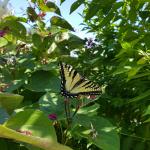 Eastern Tiger Swallowtail Butterfly: The butterflies or adult form of Papilio glaucus are large, attractive, and still present in the landscape. The caterpillars of this particular Papilio spp. have not been featured in the Landscape Message, but are a treat to view when encountered. The youngest caterpillars are bird dropping mimics, but by the fourth instar they are smooth (without hairs), green, and have a pair of black, blue, and yellow eyespots on the abdomen, close behind the head. The caterpillars utilize magnolia, sweetbay, tulip tree, cherry, ash, and others for food. This species is common to woodlands and forested areas and is a New England native. 2-3 generations may occur per year, depending on temperatures. Papilio canadensis (the Canadian tiger swallowtail) is a very similar species in appearance. Mature larvae of P. canadensis and the adults can be difficult to distinguish from P. glaucus, but tend to be more northerly in their distribution.
Eastern Tiger Swallowtail Butterfly: The butterflies or adult form of Papilio glaucus are large, attractive, and still present in the landscape. The caterpillars of this particular Papilio spp. have not been featured in the Landscape Message, but are a treat to view when encountered. The youngest caterpillars are bird dropping mimics, but by the fourth instar they are smooth (without hairs), green, and have a pair of black, blue, and yellow eyespots on the abdomen, close behind the head. The caterpillars utilize magnolia, sweetbay, tulip tree, cherry, ash, and others for food. This species is common to woodlands and forested areas and is a New England native. 2-3 generations may occur per year, depending on temperatures. Papilio canadensis (the Canadian tiger swallowtail) is a very similar species in appearance. Mature larvae of P. canadensis and the adults can be difficult to distinguish from P. glaucus, but tend to be more northerly in their distribution.

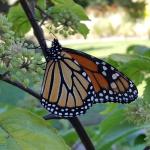 Monarch Butterfly: Danaus plexippus adult butterflies may most commonly be mistaken for the visually similar butterflies of the species Limenitis archippus or the viceroy. The quickest way to tell the two apart from a short distance would be to look for (in the viceroy) the black line that runs parallel to the end margin of the hind wing, crossing the other black lines on the hind wing that run in the opposite direction. A monarch butterfly will not have this. The caterpillars of the monarch might be one of if not the most recognizable species for many – banded with yellow, white, and black markings with black filaments rising out of abdominal segments near the head and hind ends. These caterpillars of course feed on milkweed, sequestering glycosides (cardiac toxins) which protect the caterpillars, chrysalis, and adult stages from hungry predators. This species makes the epic migration from the central and northern U.S and parts of Canada to Mexico and the coast of California for the winter. Many are interested in making their own yards and gardens hospitable places for these insects to stop along their journey. If you are looking for more information about monarchs, the U.S. Fish and Wildlife Service (https://www.fws.gov/savethemonarch/) and the University of Minnesota Monarch Lab (https://monarchlab.org/) are just two of many great places to start.
Monarch Butterfly: Danaus plexippus adult butterflies may most commonly be mistaken for the visually similar butterflies of the species Limenitis archippus or the viceroy. The quickest way to tell the two apart from a short distance would be to look for (in the viceroy) the black line that runs parallel to the end margin of the hind wing, crossing the other black lines on the hind wing that run in the opposite direction. A monarch butterfly will not have this. The caterpillars of the monarch might be one of if not the most recognizable species for many – banded with yellow, white, and black markings with black filaments rising out of abdominal segments near the head and hind ends. These caterpillars of course feed on milkweed, sequestering glycosides (cardiac toxins) which protect the caterpillars, chrysalis, and adult stages from hungry predators. This species makes the epic migration from the central and northern U.S and parts of Canada to Mexico and the coast of California for the winter. Many are interested in making their own yards and gardens hospitable places for these insects to stop along their journey. If you are looking for more information about monarchs, the U.S. Fish and Wildlife Service (https://www.fws.gov/savethemonarch/) and the University of Minnesota Monarch Lab (https://monarchlab.org/) are just two of many great places to start.
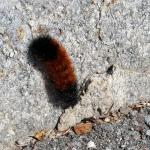
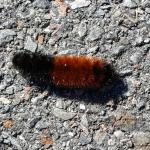 Woolly Bear Caterpillars/Isabella Tiger Moth Caterpillars: Pyrrharctia isabella is native from Canada to Florida and Texas. In the eastern US, there are 2 generations per year. The host plants of this caterpillar include many low-growing, herbaceous and woody plants such as dandelion, grass, lettuce, meadowsweet, and nettle. Nearly grown caterpillars will overwinter under the leaf litter or other protected areas, resuming feeding in the spring. They are frequently seen wandering paved roads and driveways and are most conspicuous around the time of the first frosts. The reason for this extensive wandering is unknown, and such wandering in roadways puts them in danger. Pupation occurs in the spring and adults may be present from April through September. “Rural legend” states that the width of the orange band can be used as a predictor of winter severity. Narrow brown bands supposedly indicate a cold, harsh winter whereas wide brown bands indicate a mild winter. This has been debunked – the amount of brown on the caterpillar is widely variable. With each molt of these caterpillars, the black hairs are replaced with more brown – so older instar caterpillars will have the broadest brown band.
Woolly Bear Caterpillars/Isabella Tiger Moth Caterpillars: Pyrrharctia isabella is native from Canada to Florida and Texas. In the eastern US, there are 2 generations per year. The host plants of this caterpillar include many low-growing, herbaceous and woody plants such as dandelion, grass, lettuce, meadowsweet, and nettle. Nearly grown caterpillars will overwinter under the leaf litter or other protected areas, resuming feeding in the spring. They are frequently seen wandering paved roads and driveways and are most conspicuous around the time of the first frosts. The reason for this extensive wandering is unknown, and such wandering in roadways puts them in danger. Pupation occurs in the spring and adults may be present from April through September. “Rural legend” states that the width of the orange band can be used as a predictor of winter severity. Narrow brown bands supposedly indicate a cold, harsh winter whereas wide brown bands indicate a mild winter. This has been debunked – the amount of brown on the caterpillar is widely variable. With each molt of these caterpillars, the black hairs are replaced with more brown – so older instar caterpillars will have the broadest brown band.
Woody ornamental insect and non-insect arthropod pests to consider, a selected few:
- Asian Longhorned Beetle, Anoplophora glabripennis, ALB: Look for signs of an ALB infestation which include perfectly round exit holes (about the size of a dime), shallow oval or round scars in the bark where a female has chewed an egg site, or sawdust-like frass (excrement) on the ground nearby host trees or caught in between branches. Be advised that other, native insects may create perfectly round exit holes or sawdust-like frass, which can be confused with signs of ALB activity.
The regulated area for Asian longhorned beetle is 110 miles2 encompassing Worcester, Shrewsbury, Boylston, West Boylston, and parts of Holden and Auburn. If you believe you have seen damage caused by this insect, such as exit holes or egg sites, on susceptible host trees like maple, or have captured an adult beetle that you believe to be ALB, please call the Asian Longhorned Beetle Eradication Program office in Worcester, MA at 508-852-8090 or toll free at 1-866-702-9938.
To report an Asian longhorned beetle find online or compare it to common insect look-alikes, visit: http://massnrc.org/pests/albreport.aspx or https://www.aphis.usda.gov/pests-diseases/alb/report .
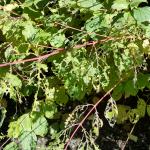
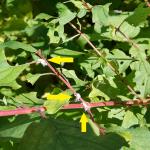
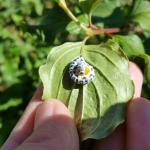 Dogwood sawfly: Macremphytus tarsatus larvae are commonly seen feeding on dogwoods, especially gray dogwood (Cornus racemosa). In the case of the photos included here, the caterpillars were found lingering on Cornus sericea ‘Budd’s Yellow’ (yellowtwig dogwood) and Cornus sanguinea ‘Midwinter Fire’ (blood twig dogwood) on October 4, 2017. One generation occurs per year. The larvae of the dogwood sawfly overwinter in decaying wood and occasionally (rarely) compromised structural timber. An overwintering “cell” is created in this soft wood. Pupation occurs in the springtime and adults can take a lengthy time to emerge, roughly from late May through July. 100+ eggs are laid in groups on the underside of leaves. Eggs hatch and the larvae feed gregariously, initially skeletonizing the leaves. As the caterpillars grow in size, they are capable of eating the entire leaf, leaving only midveins behind. Larval appearance varies greatly throughout instars. Early instars are translucent and yellow, but as the caterpillars grow, they develop black spots (over the yellow) and become covered in a white powder-like material. Larvae and their shed skins may resemble bird droppings. Full-grown larvae begin to wander in search of a suitable overwintering location. Rotting wood lying on the ground is preferred for this. At this time of year, it is late for management of this insect. Any remaining caterpillars could be collected from plants and dropped into a can of soapy water.
Dogwood sawfly: Macremphytus tarsatus larvae are commonly seen feeding on dogwoods, especially gray dogwood (Cornus racemosa). In the case of the photos included here, the caterpillars were found lingering on Cornus sericea ‘Budd’s Yellow’ (yellowtwig dogwood) and Cornus sanguinea ‘Midwinter Fire’ (blood twig dogwood) on October 4, 2017. One generation occurs per year. The larvae of the dogwood sawfly overwinter in decaying wood and occasionally (rarely) compromised structural timber. An overwintering “cell” is created in this soft wood. Pupation occurs in the springtime and adults can take a lengthy time to emerge, roughly from late May through July. 100+ eggs are laid in groups on the underside of leaves. Eggs hatch and the larvae feed gregariously, initially skeletonizing the leaves. As the caterpillars grow in size, they are capable of eating the entire leaf, leaving only midveins behind. Larval appearance varies greatly throughout instars. Early instars are translucent and yellow, but as the caterpillars grow, they develop black spots (over the yellow) and become covered in a white powder-like material. Larvae and their shed skins may resemble bird droppings. Full-grown larvae begin to wander in search of a suitable overwintering location. Rotting wood lying on the ground is preferred for this. At this time of year, it is late for management of this insect. Any remaining caterpillars could be collected from plants and dropped into a can of soapy water.
- Elongate Hemlock Scale: Fiorinia externa is found on eastern, Carolina, and Japanese hemlock, as well as yew, spruce, and fir. Crawlers will be present throughout the growing season and the overlap of many developmental stages at any given time can be observed.
- Emerald Ash Borer (EAB): EAB readily attacks ash (Fraxinus spp.) including white, green, and black ash and has also been found developing in white fringe tree (Chionanthus virginicus) and most recently, cultivated olive (Olea europaea). (See: https://academic.oup.com/jee/article-lookup/doi/10.1093/jee/tox139) Signs of an EAB infested tree may include D-shaped exit holes in the bark, “blonding” or lighter coloration of the ash bark from woodpecker feeding (chipping away of the bark as they search for larvae beneath), and serpentine galleries visible through splits in/upon peeling the bark, from larval feeding beneath. Positive identification of an EAB-infested tree may not be possible with these signs individually on their own.
For a map of the known locations of emerald ash borer in the state, as well as further information about this insect, please visit: https://ag.umass.edu/fact-sheets/emerald-ash-borer. If you believe you have located EAB-infested ash trees, particularly in an area of Massachusetts not identified on the map provided, please report it at the Massachusetts Introduced Pests Outreach Project: http://massnrc.org/pests/pestreports.htm.
- Fall Home-Invading Insects: Various insects, such as ladybugs, boxelder bugs, seed bugs, and stink bugs have begun to seek overwintering shelters in warm places, such as homes. While such invaders do not cause any measurable structural damage, they can become a nuisance especially when they are present in large numbers. If you are not willing to share your home with such insects, now should be the time to repair torn window screens, repair gaps around windows and doors, and sure up any other gaps through which they might enter the home. Brown marmorated stink bugs, Halyomorpha halys, are invasive insects that have been found in Massachusetts and can be among the offending home-invading species in the fall. For more information about the brown marmorated stink bug including how they may be distinguished from our native stinkbugs, visit https://www.massnrc.org/pests/pestFAQsheets/brownmarmoratedstinkbug.html. A great article by Deborah Swanson was recently included in UMass Extension’s Garden Clippings newsletter under “Timely Topics” regarding fall insects to recognize: https://ag.umass.edu/home-lawn-garden/newsletters/garden-clippings/garden-clippings-2017-vol-368.
- Hickory Tussock Moth: Lophocampa caryae is native to southern Canada and the northeastern United States. There is one generation per year. Overwintering occurs as a pupa inside a fuzzy, oval shaped cocoon. Adult moths emerge approximately in May and their presence can continue into July. Females will lay clusters of 100+ eggs together on the underside of leaves. Females of this species can fly, however they have been called weak fliers due to their large size. When first hatched from their eggs, the young caterpillars will feed gregariously in a group, eventually dispersing and heading out on their own to forage. Caterpillar maturity can take up to three months and color changes occur during this time. These caterpillars are essentially white with some black markings and a black head capsule. They are very hairy, and should not be handled with bare hands as sensitive individuals can have skin irritation or rashes (dermitis) as a result of interacting with hickory tussock moth hairs. (As long as they are not handled with bare skin, it is perfectly acceptable to coexist with these caterpillars.) By late September, the caterpillars usually create their oval, fuzzy cocoons hidden in the leaf litter where they will again overwinter. (However, with the warm weather we have been experiencing, many hickory tussock moth caterpillars are still present in the landscape.) Hosts whose leaves are fed upon by these caterpillars include but are not limited to hickory, walnut, butternut, linden, apple, basswood, birch, elm, black locust, and aspen. Maple and oak have also been reportedly fed upon by this insect. Several wasp species are parasitoids of hickory tussock moth caterpillars.
- Viburnum Leaf Beetle: Pyrrhalta viburni is a beetle in the family Chrysomelidae that is native to Europe, but was found in Massachusetts in 2004. Adult beetles are expected to be active roughly through October, or when the first frost hits. Adult beetles will create their own feeding damage, but will also mate and females will lay eggs in the stems of the viburnums, typically beginning in late-June to mid-July until October. This beetle feeds exclusively on many different species of viburnum including but not limited to susceptible plants such as V. dentatum, V. nudum, V. opulus, V. propinquum, and V. rafinesquianum. Some viburnum have been observed to have varying levels of resistance to this insect, including but not limited to V. bodnantense, V. carlesii, V. davidii, V. plicatum, V. rhytidophyllum, V. setigerum, and V. sieboldii. More information about viburnum leaf beetle may be found at http://www.hort.cornell.edu/vlb/.
- Chilli Thrips: The non-native, exotic chilli thrips (Scirtothrips dorsalis) has been confirmed from two samples of damaged Hydrangea spp. foliage from two residential landscapes located in Barnstable County, MA submitted to the UMass Plant Diagnostic Laboratory. At this time, this pest has not been confirmed in nurseries or greenhouses in Massachusetts or on any other host plants. Due to the limited number of samples, the significance of chilli thrips in Massachusetts is not yet known. This species of thrips is a significant global pest of economically important ornamental, vegetable, and fruit crops in southern and eastern Asia, Oceania, and parts of Africa. It was first determined to be established in the United States in 2005 in Florida, although previous interceptions of this pest were detected. It is reportedly a pest of over 100 host plants belonging to over 40 plant families, including, but not limited to, pepper, strawberry, blueberry, cotton, rose, peanut, Japanese privet, Rhododendron spp., Viburnum spp., eggplant, grapes, melon, tobacco, and tomato. For more information, please visit this Chilli Thrips Fact Sheet ( https://ag.umass.edu/landscape/fact-sheets/chilli-thrips) available on the UMass Extension Landscape, Nursery, and Urban Forestry Program web page.
Concerned that you may have found an invasive insect or suspicious damage caused by one? Need to report a pest sighting? If so, please visit the Massachusetts Introduced Pests Outreach Project: http://massnrc.org/pests/pestreports.htm.
Pollinator Protection Resource Online: The Massachusetts Department of Agricultural Resources has developed a Massachusetts Pollinator Protection Plan. It is a set of voluntary guidelines that discuss best management practices for stakeholders seeking to promote the health of the European honeybee and other pollinators. This document includes information for beekeepers, pesticide applicators, land managers and farmers, nurseries and landscapers, and homeowners and gardeners. Please locate the MA Pollinator Protection Plan for more information here: http://www.mass.gov/eea/docs/agr/farmproducts/apiary/pollinator-plan.pdf.
A note about Tick Awareness: deer ticks (Ixodes scapularis), the American dog tick (Dermacentor variabilis), and the lone star tick (Amblyomma americanum) are all found throughout Massachusetts. Each can carry their own complement of diseases. Anyone working in tick habitats (wood-line areas, forested areas, and landscaped areas with ground cover) should check themselves regularly for ticks while practicing preventative measures. Have a tick and need it tested? Visit the web page of the UMass Laboratory of Medical Zoology (https://www.tickreport.com/) and click on the red Test a Tick button for more information.
- For information about protecting yourself from ticks and tick-borne diseases, please visit: https://ag.umass.edu/landscape/fact-sheets/information-regarding-ticks-tick-borne-diseases.
- For information about managing ticks in landscapes, among other topics, please visit the following publication from the Connecticut Agricultural Experiment Station: “Tick Management Handbook”: http://www.ct.gov/caes/lib/caes/documents/publications/bulletins/b1010.pdf.
Report by Tawny Simisky, Extension Entomologist, UMass Extension Landscape, Nursery, & Urban Forestry Program
Plant of the Week
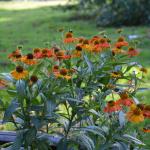
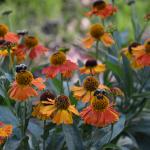 Helenium ‘Helbro’, Mardi Gras sneezeweed
Helenium ‘Helbro’, Mardi Gras sneezeweed
Helenium ‘Helbro’ is an upright, clumping, herbaceous perennial. Flowering stems are 30-40” tall. Leaves are alternate, elongated, and dark green, growing up to 4” long. ‘Mardi Gras’ has daisy-like flowers with a mix of yellow, red, and orange ray florets surrounding the brown disk center. Flowers occur from August to October, providing late season interest. Helenium ‘Helbro’ is best planted in medium to wet soil in full sun. Cutting back plants mid-summer helps to encourage branching and reduce plant height. Deadheading helps to encourage rebloom. Sneezeweed has no serious insect or disease issues but can be susceptible to powdery mildew, leaf spot, and rust. Helenium ‘Helbro’ is tolerant of wet soil making it a good choice for rain gardens, along stream banks, or wet areas. It is also a great choice for the perennial border, meadows, cottage gardens, and pollinator gardens.
Report by Mandy Bayer, Extension Assistant Professor of Sustainable Landscape Horticulture, UMass Stockbridge School of Agriculture
Additional Resources
To receive immediate notification when the next Landscape Message update is posted, be sure to join our e-mail list and follow us on Facebook and Twitter.
For a complete listing of upcoming events, see our Upcoming Educational Events page.
For commercial growers of greenhouse crops and flowers - Check out the New England Greenhouse Update website
For professional turf managers - Check out Turf Management Updates
For home gardeners and garden retailers - Check out home lawn and garden resources. UMass Extension also has a Twitter feed that provides timely, daily gardening tips, sunrise and sunset times to home gardeners, see https://twitter.com/UMassGardenClip
Diagnostic Services
A UMass Laboratory Diagnoses Landscape and Turf Problems - The UMass Extension Plant Diagnostic Lab is available to serve commercial landscape contractors, turf managers, arborists, nurseries and other green industry professionals. It provides woody plant and turf disease analysis, woody plant and turf insect identification, turfgrass identification, weed identification, and offers a report of pest management strategies that are research based, economically sound and environmentally appropriate for the situation. Accurate diagnosis for a turf or landscape problem can often eliminate or reduce the need for pesticide use. For sampling procedures, detailed submission instructions and a list of fees, see Plant Diagnostics Laboratory
Soil and Plant Nutrient Testing - The University of Massachusetts Soil and Plant Nutrient Testing Laboratory is located on the campus of The University of Massachusetts at Amherst. Testing services are available to all. The function of the Soil and Plant Nutrient Testing Laboratory is to provide test results and recommendations that lead to the wise and economical use of soils and soil amendments. For complete information, visit the UMass Soil and Plant Nutrient Testing Laboratory web site. Alternatively, call the lab at (413) 545-2311.
Ticks are active at this time! Remember to take appropriate precautions when working and playing outdoors, and conduct daily tick checks. UMass tests ticks for the presence of Lyme disease and other disease pathogens. Learn more


